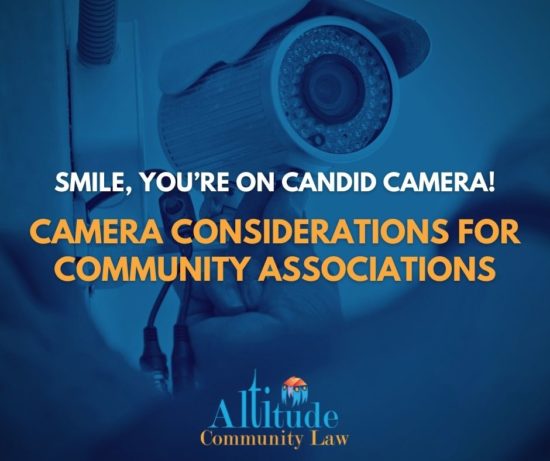
Advances in technology have resulted in increased quality and simplistic installation for camera systems at reduced pricing. As a result, camera systems continue to gain popularity, and the use of cameras in homeowner associations is becoming ever more common. However, the installation and use of these systems also have the potential to create liability. This article outlines considerations for the use of cameras within the community that can serve to establish standards and help minimize risk.
Association Installed Cameras
A common response to repeated vandalism at the community clubhouse or pool is the installation of “security” cameras. Before installing cameras, it should be understood that once an Association starts providing security, it has taken on the obligation to provide such security in a reasonable manner. Failure to do so exposes the association to potential liability.
Therefore, the association should make it clear to homeowners and residents that the cameras are installed for the purpose of protecting property only and are not intended to provide for personal safety. If the association decides to move forward with placing cameras in the community, the Board should consider taking the actions below to help minimize risk.
Post Signage
Security cameras can create a false sense of security for residents who mistakenly believe the cameras are being monitored in real-time by live security personnel. This may lead to a belief by a resident that if they are being assaulted in front of the camera that the individual monitoring the video feed will dispatch law enforcement to assist them.
However, in fact, no one is monitoring the cameras, and instead, the cameras are merely recording the events. The Association should therefore post clear and conspicuous signage near the cameras indicating that the cameras are for recording purposes only and should not be relied upon for personal safety. Such signage may include language to the effect of: “Warning: For Recording Purposes Only – Do Not Rely on Camera for Safety”.
Adopt a Camera Policy
Prior to installing cameras, the board should adopt a camera policy, and a copy of that policy should be provided to all residents within the community. The camera policy should address issues such as:
- The purpose and use of the cameras.
- The length of time video footage will be retained.
- Access rights to the video footage.
- The use of footage in connection with criminal acts, covenant violations, and the monitoring of contractor performance.
Consider Installation Locations
Cameras should be used for monitoring the common elements. Care should be taken to ensure that the Association’s cameras are not installed in a manner that would violate a resident’s reasonable expectation of privacy. As such, the Association should ensure that the cameras are not pointed into individual residences, bathrooms, or dressing room areas.
Homeowner Installed Cameras
The use of camera systems is also on the rise by individual homeowners. These may be comprehensive and complex systems that have multiple cameras placed around the home or simple doorbell-type systems. Association covenants likely require approval from an architectural review committee prior to installing cameras.
We believe it is generally advisable to allow homeowners to install camera systems to allow them to provide for their personal safety and protection of their property. However, the association should consider the following issues for homeowner installed systems:
- If the community is single-family homes, the association’s review of a proposed installation should generally be limited to architectural considerations. This means minimizing the visual impact of the cameras and requiring the system to reasonably harmonize with community aesthetics.
- If the community is a condominium community, the association may not want to allow cameras to be installed on common elements. Often, the Association is responsible for maintaining and repairing the common elements, so the association has an interest in preventing damage. In such circumstances, the association may want to limit installation to the doorbell-type systems or similar more limited systems that will allow monitoring of front entry doors and limited common elements while minimizing impact to common elements.
- Some of the systems record both video and audio, and there are laws regulating recordings. Make it clear to homeowners as part of the approval process that the association’s review and approval is based upon aesthetic considerations and that the installing homeowner is responsible for complying with applicable privacy, audio recording, and eavesdropping laws/ordinances.
Cameras in homeowner associations are here to stay. An association’s board of directors would therefore be well served to proactively consider the associated risks and take steps to implement policies addressing the issues outlined above.
If you have questions or your board would like to discuss community cameras, please contact one of our attorneys at 303.432.9999 or at [email protected].